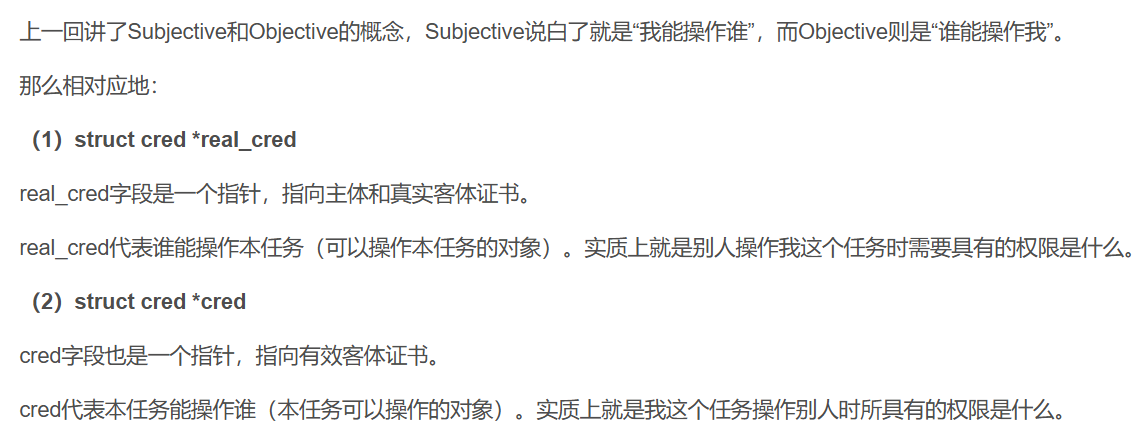Linux内核进程管理子系统有什么第三十九回 —— 进程主结构详解(35)
接前一篇文章:Linux内核进程管理子系统有什么第三十八回 —— 进程主结构详解(34)
本文内容参考:
Linux内核进程管理专题报告_linux rseq-CSDN博客
《趣谈Linux操作系统 核心原理篇:第三部分 进程管理》—— 刘超
《图解Linux内核 基于6.x》 —— 姜亚华 机械工业出版社
特此致谢!
进程管理核心结构 —— task_struct
8. 进程权限相关成员
进程权限相关成员包括以下几个:
/* Process credentials: *//* Tracer's credentials at attach: */const struct cred __rcu *ptracer_cred;/* Objective and real subjective task credentials (COW): */const struct cred __rcu *real_cred;/* Effective (overridable) subjective task credentials (COW): */const struct cred __rcu *cred;这几个字段的描述如下:

上一回对于进程权限相关的字段进行了解析,本回对于这3个字段的共同类型struct cred进行详细解析。
struct cred的定义在include/linux/cred.h中,如下:
/** The security context of a task** The parts of the context break down into two categories:** (1) The objective context of a task. These parts are used when some other* task is attempting to affect this one.** (2) The subjective context. These details are used when the task is acting* upon another object, be that a file, a task, a key or whatever.** Note that some members of this structure belong to both categories - the* LSM security pointer for instance.** A task has two security pointers. task->real_cred points to the objective* context that defines that task's actual details. The objective part of this* context is used whenever that task is acted upon.** task->cred points to the subjective context that defines the details of how* that task is going to act upon another object. This may be overridden* temporarily to point to another security context, but normally points to the* same context as task->real_cred.*/
struct cred {atomic_t usage;
#ifdef CONFIG_DEBUG_CREDENTIALSatomic_t subscribers; /* number of processes subscribed */void *put_addr;unsigned magic;
#define CRED_MAGIC 0x43736564
#define CRED_MAGIC_DEAD 0x44656144
#endifkuid_t uid; /* real UID of the task */kgid_t gid; /* real GID of the task */kuid_t suid; /* saved UID of the task */kgid_t sgid; /* saved GID of the task */kuid_t euid; /* effective UID of the task */kgid_t egid; /* effective GID of the task */kuid_t fsuid; /* UID for VFS ops */kgid_t fsgid; /* GID for VFS ops */unsigned securebits; /* SUID-less security management */kernel_cap_t cap_inheritable; /* caps our children can inherit */kernel_cap_t cap_permitted; /* caps we're permitted */kernel_cap_t cap_effective; /* caps we can actually use */kernel_cap_t cap_bset; /* capability bounding set */kernel_cap_t cap_ambient; /* Ambient capability set */
#ifdef CONFIG_KEYSunsigned char jit_keyring; /* default keyring to attach requested* keys to */struct key *session_keyring; /* keyring inherited over fork */struct key *process_keyring; /* keyring private to this process */struct key *thread_keyring; /* keyring private to this thread */struct key *request_key_auth; /* assumed request_key authority */
#endif
#ifdef CONFIG_SECURITYvoid *security; /* LSM security */
#endifstruct user_struct *user; /* real user ID subscription */struct user_namespace *user_ns; /* user_ns the caps and keyrings are relative to. */struct ucounts *ucounts;struct group_info *group_info; /* supplementary groups for euid/fsgid *//* RCU deletion */union {int non_rcu; /* Can we skip RCU deletion? */struct rcu_head rcu; /* RCU deletion hook */};
} __randomize_layout;
先来仔细研读一下Linux内核对于struct cred的注释:
struct cred —— (一个)任务的安全上下文
上下文的各个部分分为两类:
(1) 任务的客体上下文
当其它任务试图影响此任务时,会使用这些部分。
(2) 主体上下文
当任务作用于另一个对象时,无论是文件、任务、密钥还是其它任何对象,都会使用这些详部分。
注意:struct cred的一些成员属于这两个类别,例如LSM安全指针。
一个任务有两个安全指针:task->real_cred和task->cred。
- task->real_cred指向定义该任务实际细节的客体上下文。每当执行该任务时,都会使用此上下文的客体部分。
- task->cred指向主体上下文,该上下文定义了任务将如何作用于另一个对象的细节。这可能会被临时覆盖以指向另一个安全上下文,但通常会指向与task->real_cred相同的上下文。

从struct cred的定义可以看出,大部分是关于用户和用户所属的用户组信息。
- 第1组 —— kuid_t uid和kgid_t gid
uid和pid的注释分别是real UID/PID of the task。
一般情况下,谁启动的进程,就是谁的ID。但是权限审核的时候,往往不比较这两个,也就是说不大起作用。
- 第2组 —— kuid_t euid和kgid_t egid
euid和egid的注释分别是effective UID/GID of the task。
一看这个名字effective,就知道这个是起实际作用的。当这个进程要操作消息队列、共享内存、信号量等对象的时候,其实就是在比较这个用户和组是否有权限。
- 第3组 —— kuid_t fsuid和kgid_t fsgid
fsuid和fsgid的注释分别是UID/GID for VFS ops。实际上就是filesystem UID/GID。
这是对文件操作会审核的权限。
更多内容请看下回。
